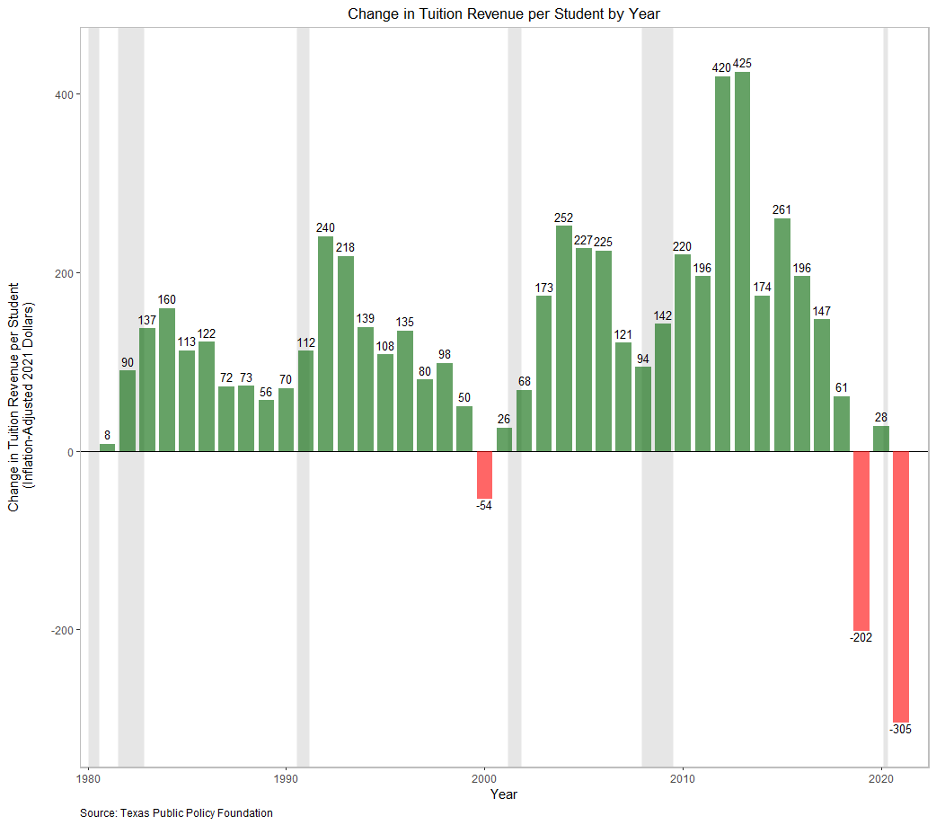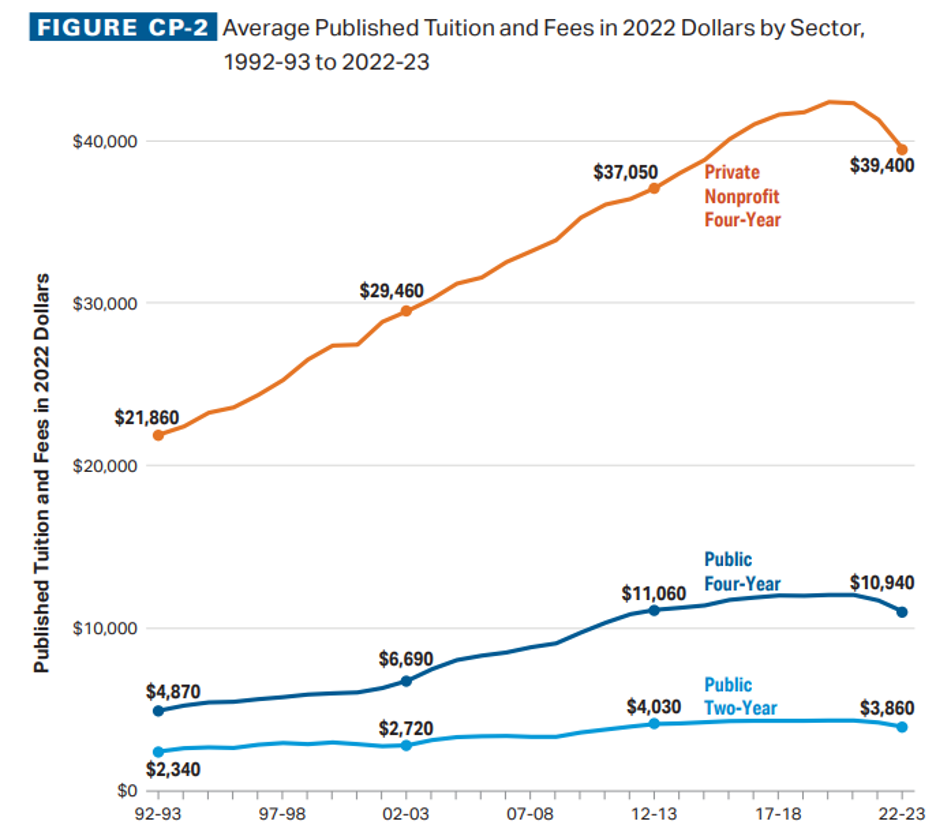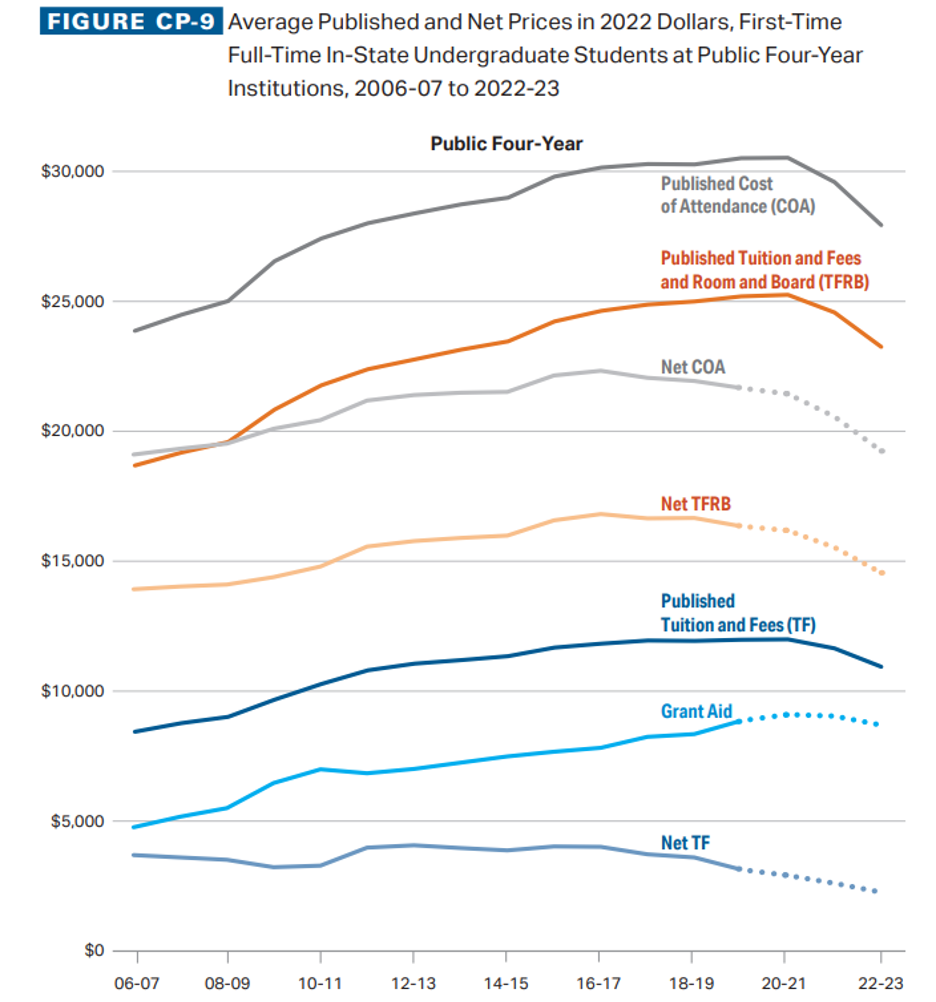
While it’s understandable to get riled up about the latest outrage on campus, there is some potential good news that we shouldn’t fail to notice: After decades of continuously increasing, college tuition now appears to be trending down. While the level of tuition may still be too high (decades of sustained increases will do that), it is at least moving in the right direction now.
The data from the U.S. Department of Education to conclusively confirm the trend is still a year or two away, but two recent reports suggest a large and sustained decrease in tuition over the past few years.
The first is the annual State Higher Education Finance report published by the State Higher Education Executive Officers Association. My annual reanalysis of their data, which adds an inflation adjustment, documents that at public universities across the country, tuition revenue has fallen by about $500 per student over the past three years (see the reproduced figure below).

While it’s consistent with a decrease in tuition, a decrease in tuition revenue could theoretically be caused by something else, such as a decrease in federal grants combined with some Bennett Hypothesis effects (federal grants to students show up as tuition revenue from the college’s perspective).
[Related: “Top Five Underappreciated Scandals from Biden’s Student Loan Forgiveness Plan”]
The most convincing evidence of the decline in tuition is provided by the College Board’s annual Trends in College Pricing and Student Aid report, which explicitly tracks tuition. As can be seen in the reproduced figure below, the three dominant sectors of higher education have all seen tuition fall recently.

Source: College Board
To illustrate the decline in more detail, consider four-year public colleges. The reproduced figure below shows all the important affordability metrics. Tuition and fees, tuition and fees and room and board, and cost of attendance (the formal name for total costs including books, travel, etc.) have all fallen over the past few years. The “net” versions of these metrics (which indicate how much students and parents pay after any grant aid) have also fallen, in part because of an increase in grant aid but also in part because of decreases in tuition or other costs. The net cost of attendance (Net COA in the figure below) is the most comprehensive measure of the total price that students and parents pay, and it has fallen by $2,200 in just the past two years (a 10% decline).

Source: College Board
Given these substantial and sustained decreases, we can tentatively argue (pending confirmation through U.S. Department of Education data in a couple years) that we’ve reached an inflection point where tuition is no longer on a sustained upward trajectory.
This immediately raises two questions. 1) What has caused the recent decrease in tuition? And 2) Will the decrease in tuition continue?
Unfortunately, we don’t yet know the answers to these questions. First, there simply hasn’t been much analytical power devoted to the question of why tuition decreases, since, for generations, that would have been a purely hypothetical question. Second, I’m not aware of anyone who predicted a drop of this magnitude, which means we don’t have any gurus with ready-made explanations sitting on the shelf.
[Related: “Biden’s New Student Loan Repayment Plan Would Ruin Student Lending”]
If pressed, I would venture two leading hypotheses—though at this point, they are so speculative that they barely deserve the scientific veneer of being called hypotheses.
The first hypothesis notes that two things which haven’t happened for decades both happened almost simultaneously: enrollments fell, and tuition fell. Perhaps they’re related. In the past, even though enrollment would occasionally dip after surging during recessions, the trend line was clearly upward—until now. In the last two years, enrollments have fallen by 3.2%. This may have left colleges scrambling to fill seats, and ultimately using price cuts to do so.
If this is the case, then enrollments are driving tuition, and the decline in both may be temporary. My sense is that one of the primary reasons for the decline in enrollments was the inordinate COVID-19 response on campuses. As Auguste Meyrat wrote, “many students saw little reason to pay tens of thousands of dollars for an experience that amounted to house arrest combined with Khan Academy.” If that is the case, then as colleges drop excessive COVID protocols, enrollments will rebound, and tuition may too.
The second hypothesis notes that, several years ago, we unleashed a data tsunami on higher education, which has revealed to students the actual earnings of recent graduates by program (a program is a credential/major/college combination such as the bachelor’s degree in accounting from Ohio State). This has the potential to revolutionize higher education:
For years we’ve asked students to make one of life’s most important decisions essentially blindfolded. We’ve told them a college degree is the surest path to success but have given them little guidance on where to go to college or what major to choose once they get there. As a result, too many students leave with a mountain of debt and a credential that isn’t worth much on the labor market. The new data will help equip students — and their parents — with the information necessary to avoid these costly mistakes.
If the new data allowed students to avoid programs that don’t pay off, this could explain both the decline in enrollment and the decline in tuition (as colleges try to cut costs enough to make their program worthwhile). If this is the case, then the decline in tuition will likely continue until there is a competitive equilibrium between educational costs and educational benefits.
Whether or not either of these hypotheses has any validity, there is also the elephant in the room regarding how colleges will respond to Biden’s student loan forgiveness plan (currently in limbo in the courts). If the loan forgiveness goes through, it seems likely that colleges will raise tuition to exploit the perception that student loans are now just delayed grants.
But in the meantime, we can at least be grateful that college has gotten more affordable lately.
Image: Adobe Stock
Whether this is “good news” is open to question.
The tuition decline is, in fact, enrollment-driven. (Not sure why the author is unsure of this; everybody in academia knows it.) Colleges are becoming increasingly desperate to fill their classes, and so are discounting tuition more and more. But for many schools those discounts are unsustainable. That is, unless they can find a way to cut costs dramatically (of course they could, but it doesn’t mean they will), they are going to go out of business in a few years due to inadequate revenues, unless they hike tuition back up — which will probably drive down enrollment, thereby putting them out of business in a few years due to inadequate revenues. That is, this is a sign of a very sick industry.
So parents may be happy that they’re paying less to send Johnny to college right now, but Johnny’s college may go bankrupt before he graduates. And even if it makes it past then, it may close a few years later, which is still not good.
Well, this trend isn’t universal. Fall 2021 my university was shut down because of COVID; zoom classes only. Yet that didn’t stop them from raising the tuition that very term.
Is there a growing schism between tuition at engineering schools — whose degrees still have employment value — and liberal arts ones?
Yes, let’s be grateful for covid and inflation. Thanks a lot.
“…the decline in tuition will likely continue until there is a competitive equilibrium between educational costs and educational benefits..”
There is a wild card here as well — an increasing number of employers are no longer requiring applicants possess a college degree. If this trend continues — and there is no reason to believe that it won’t — then the value of the educational benefits will continue to decrease.
This could create a perfect storm where educational costs spiral downward in an attempt to catch rapidly declining educational benefits — with an increasing percentage of the cadre not going to college as well. Ever since the 1950s, the percentage of young people going to college has always been increasing — along with the percentage of jobs requiring a college degree.
” I’m not aware of anyone who predicted a drop of this magnitude, which means we don’t have any gurus with ready-made explanations sitting on the shelf.”
Not exactly.
Back in 2019, Before Covid, there was a great deal of discussion about the fact that tuition discounting had grown to average something like 47%, with institutions considering lowering their tuition to what they actually charged so as to get a handle on this.
Could it be that this is what is happening here?
There also is the very real issue of not enough young people to fill all the seats in higher education today, and the demographic bottom will drop out in the Fall of 2026 when the children who weren’t born in 2008 won’t be turning 18.
And the other shoe to drop is all the institutions which likely would have already gone bankrupt but for the various Covid bailouts. They’re not going to advertise that they’re treading water financially. Throw in higher energy costs — they use a lot of electricity — and it will be interesting to see what happens with the Covid largess finally runs out.